Myth: Guns are the leading cause of death for children
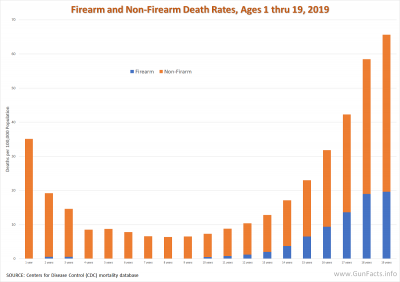 Fact: There are criminology and health care definitions for “child” (prepubescent) and “teens”. The national Gang Center notes that street gang recruitment begins at age 14. This the principle reason why gun deaths are nearly nonexistent for children, but steadily rise for teens.
Fact: There are criminology and health care definitions for “child” (prepubescent) and “teens”. The national Gang Center notes that street gang recruitment begins at age 14. This the principle reason why gun deaths are nearly nonexistent for children, but steadily rise for teens.
Myth: There have been 96 school shootings since Sandy Hook
Fact: This analysis of news reports was created by the gun control group Everytown. This study included:
- College campuses (47% of cases)
- Suicides attempts (18%)
- Cases where nobody was hurt (27%)
Some other analysts note that many of the cases are unrelated to school activity or actually occurred near campus, not on it. All in all, it is a poor study with no relevance to child endangerment.
Myth: 240 schools had a school related shooting in 2015-16
(also “over 100 schools reported a school-related homicide”)
Fact: This Education Department “study” 1 was utterly botched, to the point where they logged 16 shooting of one school district, but an NPR investigation 2showed zero. In 161 cases, schools or districts attested that no incident took place. In at least four cases, something did happen, but it didn’t meet the government’s parameters for a shooting.
Myth: 13 children are killed each day by guns
Fact: Adults included – This “statistic” includes “children” up to age 19 or 24, depending on the source. 3 Since most violent crime is committed by males ages 16-24, the “13 children” number includes adult gang members dying during criminal activity. The proper definition of ‘child’ is a person between birth and puberty (typically 13-14 years old) and in 2013 only 1 child was killed on an average day nationwide, or about 0.02 children per state per day.
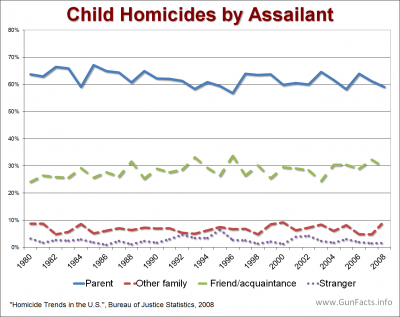 Fact: 411 children (age 14 and under) died from gunfire in all of 2012 or slightly more than one per day. This includes homicides, accidents, and suicides combined. 4
Fact: 411 children (age 14 and under) died from gunfire in all of 2012 or slightly more than one per day. This includes homicides, accidents, and suicides combined. 4
Fact: Criminals are included – According to the CDC, over half of all homicides of victims aged 15-19 are gang-related. The same study found that gang-related homicides are more likely to involve firearms than those that are not (95% versus 69%). 5
Fact: Suicides are included – 26% of child firearm deaths are suicides. Hence, the “13 children” statistic includes these suicides. 6
Fact: For contrast:
- 1,446 children die per year in transportation accidents. 7
- Parental neglect and abuse account for 80% of all child deaths (1,274) which dwarfs gun deaths. 8
- 1,917 children die each day from malaria 9 around the world and 15 men, women, and children per day are murdered by a convicted felon in government supervised parole/probation programs in the U.S. 10
Myth: More Guns in U.S. Homes, More Kids Getting Shot
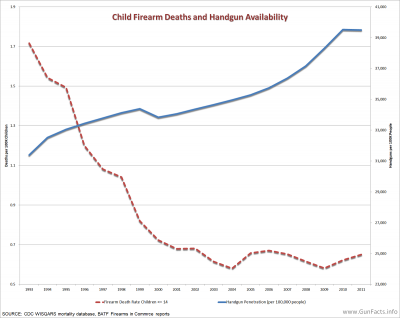 Fact: This study 11, published by a medical student, used a non-standard database (not official CDC records), did not analyze other variables (multi-variant analysis) and did not specify regional co-variance in gun ownership. In short, shabby science.
Fact: This study 11, published by a medical student, used a non-standard database (not official CDC records), did not analyze other variables (multi-variant analysis) and did not specify regional co-variance in gun ownership. In short, shabby science.
Myth: Schoolyard shootings are an epidemic
Fact: “Compared to other types of violence and crime children face, both in and outside of school, school-based attacks are rare. While the Department of Education reports 60 million children attend the nation’s 119,000 schools, available statistics indicate that few of these students will fall prey to violent situations in school settings.” 12
Fact: Over an eight year period, in states without “right to carry” laws, there were 15 school shootings; however, in states that allow citizens to carry guns, there was only one. 13
Fact: The five school shootings that occurred during the ’97-98 school year took place after the 1995 Gun-Free School Zones law was enacted, which banned guns within 1,000 feet of a school. 14
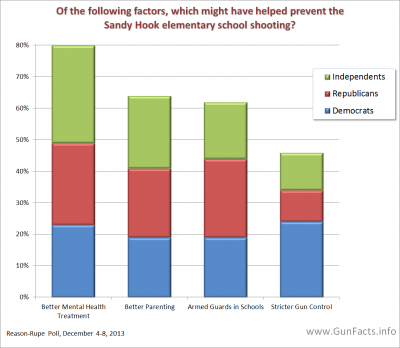 Fact: Schoolyard shooting deaths are not rising, rather; they have been falling through most of the 1990s: 15
Fact: Schoolyard shooting deaths are not rising, rather; they have been falling through most of the 1990s: 15
Fact: Only 10% of public schools reported one or more serious violent crimes during the 1996-97 school year. 16
Fact: In Pearl, Mississippi, the assistant principal carried a firearm to the school until the 1995 “Gun-Free School Zones” law passed. Afterwards he began locking his firearm in his car and parking at least a quarter-mile away from the school. In 1997, when a student began a shooting rampage, the assistant principal ran to his car, got his gun, ran back, disarmed the shooter, and held him on the ground until the police arrived. Had the law not been passed, the assistant principal might have prevented the two deaths and seven shooting-related injuries.
Fact: Similar prevention occurred at a school dance in Edinboro, Pennsylvania, the Appalachian School of Law and during classes in Santee, California.
Myth: Trigger locks will keep children from accidentally shooting themselves
Fact: 31 of 32 models of gun locks tested by the government’s Consumer Product Safety Commission could be opened without the key. According to their spokesperson, “We found you could open locks with paper clips, a pair of scissors or tweezers, or you could whack them on the table and they would open.” 17
Fact: 85% of all communities in America recorded no juvenile homicides in 1995, and 93.4% of communities recorded one or no juvenile arrests (not convictions) for murder. 18
Fact: In 1996, before laws requiring trigger locks and when there were around 80 million people who owned a firearm, there were only 44 accidental gun deaths for children under age 10, or about 0.0001%. 19
Fact: California has a trigger lock law and saw a 12% increase in fatal firearm accidents in 1994. Texas didn’t have one and experienced a 28% decrease in the same year. 20
Fact: Children as young as seven (7) years old have demonstrated that they can pick or break a trigger lock; or that they can operate a gun with a trigger lock in place. 21 Over half of non-criminal firearm deaths for children over age seven are suicides, so trigger locks are unlikely to reduce these deaths.
Fact: If criminals are deterred from attacking victims because of the fear that people might be able to defend themselves, gun locks may in turn reduce the danger to criminals committing crime, and thus increase crime. This problem is exacerbated because many mechanical locks (such as barrel or trigger locks) also require that the gun be stored unloaded.
Myth: Guns in America spark youth violence
Fact: Non-firearm juvenile violent crime rate in the U.S. is twice that of 25 other industrialized western nations. The non-firearm infant-homicide rate in the U.S. is 3.5 times higher. 22 Thus we have a violence problem – not a “gun” problem.
Fact: Non-firearm related homicides of children out-rank firearm related homicides by children almost 5-to-1 23
Myth: More than 1,300 children commit suicide with guns
Fact: This statistic includes “children” ages 18-19. 24 As established previously, a child is defined as a person between birth and the age of 13 or 14 (puberty).
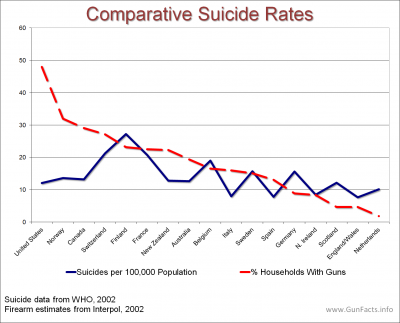 Fact: Worldwide, the per capita suicide rate is fairly static (the suicide rate of the U.S. is lower than many industrial countries, including many where private gun ownership is banned). A certain fraction of the population will commit suicide regardless of the available tools.
Fact: Worldwide, the per capita suicide rate is fairly static (the suicide rate of the U.S. is lower than many industrial countries, including many where private gun ownership is banned). A certain fraction of the population will commit suicide regardless of the available tools.
Fact: The overall rate of suicide (firearm and non-firearm) among children age 15 and under was virtually unchanged in states that passed and maintained “safe storage” laws for four or more years. 25
Fact: Among young girls, 71% of all suicides are by hanging or suffocation. 26
Fact: People, including children, who are determined to commit suicide will find a way. There is a documented case of a man who killed himself by drilling a hole in his skull by using a power drill. 27
Fact: Banning country music might be more effective – one study shows 51% of the music-influenced suicide differential can be traced to country music. 28
Myth: Stricter gun control laws could have prevented the Columbine massacre
Fact: Harris and Klebold violated close to 20 firearms laws in obtaining weapons. Would 21 laws really have made a difference? The two shotguns and one rifle used by Harris and Klebold were purchased by a girlfriend who passed a background check, and the TEC-9 handgun used was already banned.
Myth: Gun-Free school zones reduce campus shootings
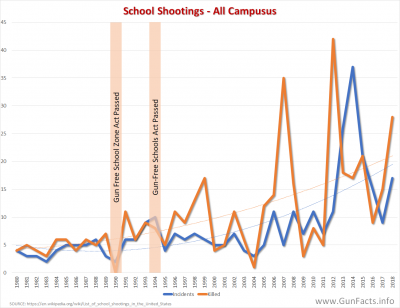 |
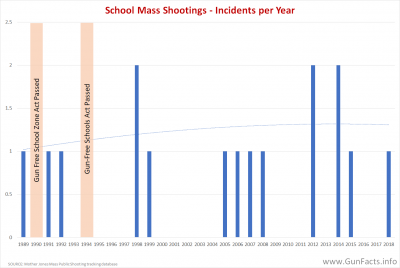 |
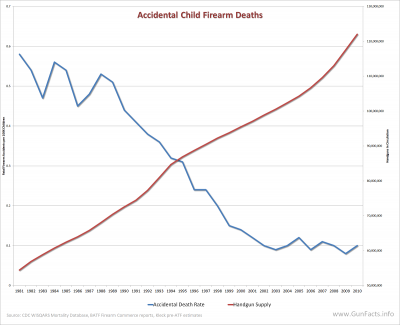 |
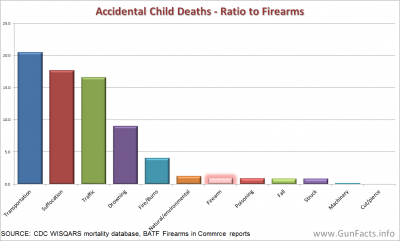 |
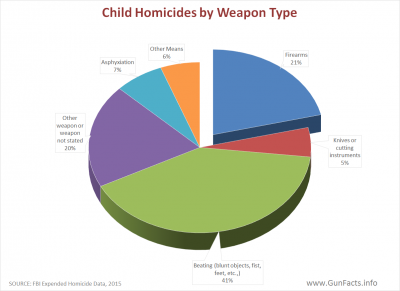 |
Fact: The trends after two major federal gun-free school zone acts show that they have no effect. Indeed, the number of campus shooting events, the number of people killed, and even the number of mass shootings (albeit statistically fragile) have increased.
Myth: Children should be kept away from guns for their own safety
Fact: 0% of children that get guns from their parents commit gun-related crimes while 21% of those that get them illegally do. 29
Fact: Children that acquire firearms illegally are twice as likely to commit street crimes (24%) than are those given a firearm by their parents (14%). 30
Fact: Almost three times as many children (41%) consume illegal drugs if they also obtain firearms illegally, as compared to children given a firearm by their parents (13%).
Fact: In the 1950’s, children routinely played cops and robbers, had toy guns, were given BB rifles and small caliber hunting rifles before puberty. Yet the homicide rate in the 1950’s was almost half of that in the 1980’s. 31
Myth: More children are shot and killed in the U.S. than anywhere else
Fact: 380 children age 14 or under were killed with firearms 32 in 2010, or 0.0005% of the children in America and barely more than one child per day. Of those, 58% of those were homicides, likely innocent bystanders in drive-by scenarios.
Myth: More children are hurt with guns than by any other means
Fact: Barely more than 1% of all unintentional deaths for children in the U.S. between ages 0-14 are from firearms. 33
Fact: The Center for Disease Control, a federal agency, disagrees. According to them, in 1998, children 0-14 years died from the following causes in the U.S. 34
Fact: Children are 12 times more likely to die in an automobile accident than from gun-related homicides or legal interventions (being shot by a police officer, for example) if they are age 0-14. For the group 0-24 years old (which bends the definition of “child” quite a bit), the rate is still 8.6 times higher for cars. 35
Fact: In 2001, there were only 72 accidental firearm deaths for children under age 15, as opposed to over 2,100 children who drowned (29 times as many drowning deaths as firearm deaths). 36
Fact: Accidental firearm injuries for children and adolescents dropped 37% from 1993 to 1997, with the fastest drop — a 64% reduction — being for children. 37
Fact: Boys who own legal firearms have much lower rates of delinquency and drug use than non-owners of guns. 38
Fact: The non-gun homicide rate of children in the U.S. is more than twice as high as in other western countries. And eight times as many children die from non-gun violent acts than from gun crimes. 39 This indicates that the problem is violence, not guns.
Fact: Fatal gun accidents for children ages 0-14 declined by almost 83% from 1981 to 2002 40 – all while the number of handguns per capita increased over 41%. 41
Fact: 82% of homicides of children age 13 and under were committed without a gun. 42
Myth: States with background checks have fewer school shootings
Fact: This was the incorrect conclusion of a very odd and extremely limited study by a medical school (not a criminology study). The study used odd and atypical control variables, but it also concluded that urban residency was a better predictor.
Myth: Gun safety training for children is ineffective
Fact: Once randomized trail 43 concluded that “watching a gun safety video reduced children’s unsafe behavior around real guns.” They noted that “Those who saw the gun safety video were more likely to tell an adult about the gun they found (38 of 112 [33.9%] vs 11 of 104 [10.6%]), were less likely to touch the gun (44 of 112 [39.3%] vs 70 of 104 [67.3%]), were less likely to pull the trigger at all (10 of 112 [8.9%] vs 31 of 104 [29.8%]).”
Myth: If it saves the life of one child, it is worth it
Fact: Firearms in private hands are used an estimated 2.5 million times (or 6,849 times each day) each year to prevent crime; 44 this includes rapes, aggravated assaults, and kidnapping. The number of innocent children protected by firearm owners far outweighs the number of children harmed.
Fact: Most Americans (firearm owners or not) believe that the way parents raise kids is what causes gun violence (or just violence in general). Among non-firearm owners, 38% said it was parental neglect that causes youth violence, while only 28% thought it was due to the availability of guns. 45 They may be right, given that most homicides of children under age five are by their own parents. Of homicides among children ages 5 and younger; 31% were killed by their own mothers and another 31% were killed by their own fathers. 46
Notes:
- School Climate and Safety, U.S. Department of Education, April, 2018 ↩
- The School Shootings That Weren’t, NPR, August 2018 ↩
- Center for Disease Control WISQARS Fatal Injury Reports for 2013 ↩
- Center for Disease Control WISQARS Fatal Injury Reports for 2010 ↩
- CDC Morbidity and Mortality Weekly Report: “Gang Homicides — Five U.S. Cities, 2003-2008”, published January 27, 2012 ↩
- Center for Disease Control WISQARS Fatal Injury Reports for 2012 ↩
- Center for Disease Control WISQARS Fatal Injury Reports for 2012 ↩
- Child Abuse and Neglect Fatalities 2012, Child Welfare Information Gateway, U.S. Department of Health and Human Services ↩
- Fact Sheet No 178, U.N. World Health Organization, 1998 ↩
- US Bureau of Justice Statistics, 1998 ↩
- United States Childhood Gun-Violence—Disturbing Trends, Madenci, American Academy of Pediatrics ↩
- Threat Assessment in Schools, U.S. Secret Service and U.S. Department of Education, May 2002 ↩
- Multiple Victim Public Shootings, Bombings, and Right-to-Carry Concealed Handgun Laws: Contrasting Private and Public Law Enforcement, Lott J, Landes W; University of Chicago – (covers years 1977 to 1995) ↩
- Multiple Victim Public Shootings, Bombings, and Right-to-Carry Concealed Handgun Laws: Contrasting Private and Public Law Enforcement, Lott J, Landes W; University of Chicago – (covers years 1977 to 1995) ↩
- Violence and Discipline Problems in U.S. Public Schools, National Center for Education Statistics,1996-97 ↩
- Principal/School Disciplinarian Survey on School Violence, Department of Education, March 2000 ↩
- Washington Post, Feb 7, 2001, Page A01 ↩
- Crime in the United States: Uniform Crime Reports, Federal Bureau of Investigation, 1996 ↩
- CBS News web site, Prof. John Lott, March 20, 2000 ↩
- National Center for Health Statistics, 1995 ↩
- Accidental Shootings: many deaths and injuries caused by firearms could be prevented, United States General Accounting Office, March 1991 ↩
- Kids and Guns Bulletin, Centers for Disease Control and Prevention statistics, 2000. (covers years 1990-1995) ↩
- FBI Uniform Crime Statistics, 1997 ↩
- Determined using CDC mortality data, and finding the only possible fit for the claim ↩
- Accidental Deaths, Suicides, and Crime Safe Storage Gun Laws, John Lott, Yale Law School, 2000 ↩
- Suicide Trends Among Youths and Young Adults Aged 10–24 Years — United States, 1990–2004, Center for Disease Control, September 2007 ↩
- Drilled Head Husband Dies in Hospital, The Scotsman, April 28, 2003 ↩
- The Effect of Country Music on Suicide, Steven Stack, Jim Gundlach, Social Forces. Volume: 71. Issue: 1., 1992 ↩
- Urban Delinquency and Substance Abuse, U.S. Justice Department, 2000 ↩
- Urban Delinquency and Substance Abuse, U.S. Justice Department, 2000 ↩
- Vital Statistics, National Center for Health Statistics, Revised July 1999 ↩
- Center for Disease Control, WISQARS Fatal Injury Reports, 2010 ↩
- Deaths: Final Data for 2006, National Vital Statistics Reports, 2009, Center for Disease Control ↩
- Deaths: Final for 1998, Center for Disease Control, vol. 48 no. 11., July 24, 2000 ↩
- National Vital Statistics Report, National Center for Health Statistics, 1997 ↩
- 20 Leading Causes of Unintentional Injury Deaths, Center for Disease Control, United States, 2001, (All Races, Both Sexes, Ages: 1-14) ↩
- Firearms Injury Surveillance Study, Centers for Disease Control and Prevention, December 2001 ↩
- Urban Delinquency and Substance Abuse, U.S. Department of Justice, National Institute of Justice, Office of Juvenile Justice and Delinquency Prevention, NCJ-143454, August 1995 ↩
- Kids and Guns, Office of Juvenile Justice and Delinquency Prevention, 2000 ↩
- National Center for Health Statistics ↩
- BATF estimates on handguns in circulation, BATF, Firearms Commerce in the United States 2001/2002 ↩
- FBI Uniform Crime Statistics, 1997 ↩
- Effect of a Gun Safety Video on Children’s Behavior Around Real Guns: A Randomized Clinical Trial; Kjærvik, Bushman; JAMA Network; 2023 ↩
- Gary Kleck, Criminologist, Florida State University, 1997 ↩
- Gallup/Women.com poll, May 2000 ↩
- FBI, Supplementary Homicide Reports, 1976-98 ↩

